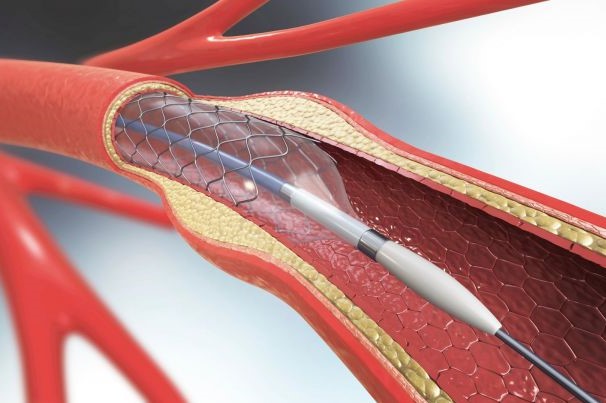
Coronary artery bypass surgery: what it is and when to use it
The purpose of coronary artery bypass surgery is to bypass narrowings (stenosis), i.e. occlusions resulting from atherosclerosis, of the coronary arteries, which are the vessels responsible for maintaining a constant blood supply to the heart muscle, essential for maintaining effective cardiac activity
The reduced supply of oxygen and nutrients to the heart muscle can cause serious cardiovascular events that can be
- transient, such as angina pectoris
- irreversible due to prolonged coronary obstruction, such as heart attack.
What does coronary bypass surgery consist of?
The cardiac bypass technique most often consists of a longitudinal incision in the middle of the anterior chest wall through the sternum (median sternotomy).
The patient is connected with cannulas to the extracorporeal circulation circuit, the venous blood is drained, oxygenated and pumped back into the aorta: this circuit keeps the patient alive.
The coronary artery bypass bypass allows the narrowing of the coronary vessel to be bypassed by inserting a vascular conduit upstream and downstream of the narrowing point to restore good flow downstream of the stenosis.
The conduits used for the graft are either vein segments taken from the patient’s own leg (thus not subject to rejection), or an artery, the internal mammary artery, which runs inside the chest.
The proximal end of the saphenous vein is sutured to a section of the aorta so that the blood from it, through the vein, reaches the coronary artery at the site of the obstruction.
If the mammary artery is used, there is no need to connect it proximally, as it originates physiologically from an arterial system (to the subclavian artery).
Is cardiac bypass risky?
In general, the mortality rate of coronary artery bypass surgery is about 1% in elective cases, which is considerably lower than the risk of myocardial infarction that patients who are not candidates for the operation would face, with an average hospital stay most often of 7-8 days.
Bypass surgery of the heart has now become a routine technique with precise and rational indications.
Read Also
Emergency Live Even More…Live: Download The New Free App Of Your Newspaper For IOS And Android
Interventricular Septal Defect: What It Is, Causes, Symptoms, Diagnosis, And Treatment
Supraventricular Tachycardia: Definition, Diagnosis, Treatment, And Prognosis
Ventricular Aneurysm: How To Recognise It?
Atrial Fibrillation: Classification, Symptoms, Causes And Treatment
EMS: Pediatric SVT (Supraventricular Tachycardia) Vs Sinus Tachycardia
Atrioventricular (AV) Block: The Different Types And Patient Management
Pathologies Of The Left Ventricle: Dilated Cardiomyopathy
A Successful CPR Saves On A Patient With Refractory Ventricular Fibrillation
Atrial Fibrillation: Symptoms To Watch Out For
Atrial Fibrillation: Causes, Symptoms And Treatment
Difference Between Spontaneous, Electrical And Pharmacological Cardioversion
‘D’ For Deads, ‘C’ For Cardioversion! – Defibrillation And Fibrillation In Paediatric Patients
Inflammations Of The Heart: What Are The Causes Of Pericarditis?
Do You Have Episodes Of Sudden Tachycardia? You May Suffer From Wolff-Parkinson-White Syndrome (WPW)
Knowing Thrombosis To Intervene On The Blood Clot
Patient Procedures: What Is External Electrical Cardioversion?
Increasing The Workforce Of EMS, Training Laypeople In Using AED
Heart Attack: Characteristics, Causes And Treatment Of Myocardial Infarction
Altered Heart Rate: Palpitations
Heart: What Is A Heart Attack And How Do We Intervene?
Do You Have Heart Palpitations? Here Is What They Are And What They Indicate
Palpitations: What Causes Them And What To Do
Cardiac Arrest: What It Is, What The Symptoms Are And How To Intervene
Electrocardiogram (ECG): What It Is For, When It Is Needed
What Are The Risks Of WPW (Wolff-Parkinson-White) Syndrome
Heart Failure: Symptoms And Possible Treatments
What Is Heart Failure And How Can It Be Recognised?
Inflammations Of The Heart: Myocarditis, Infective Endocarditis And Pericarditis
Quickly Finding – And Treating – The Cause Of A Stroke May Prevent More: New Guidelines
Atrial Fibrillation: Symptoms To Watch Out For
Wolff-Parkinson-White Syndrome: What It Is And How To Treat It
Do You Have Episodes Of Sudden Tachycardia? You May Suffer From Wolff-Parkinson-White Syndrome (WPW)
What Is Takotsubo Cardiomyopathy (Broken Heart Syndrome)?
Heart Disease: What Is Cardiomyopathy?
Inflammations Of The Heart: Myocarditis, Infective Endocarditis And Pericarditis
Heart Murmurs: What It Is And When To Be Concerned
Broken Heart Syndrome Is On The Rise: We Know Takotsubo Cardiomyopathy
Heart Attack, Some Information For Citizens: What Is The Difference With Cardiac Arrest?
Heart Attack, Prediction And Prevention Thanks To Retinal Vessels And Artificial Intelligence
Full Dynamic Electrocardiogram According To Holter: What Is It?
In-Depth Analysis Of The Heart: Cardiac Magnetic Resonance Imaging (CARDIO – MRI)
Palpitations: What They Are, What Are The Symptoms And What Pathologies They Can Indicate
Cardiac Asthma: What It Is And What It Is A Symptom Of
Cardiac Rhythm Restoration Procedures: Electrical Cardioversion
Abnormal Electrical Activity Of The Heart: Ventricular Fibrillation
Gastro-Cardiac Syndrome (Or Roemheld Syndrome): Symptoms, Diagnosis And Treatment
Cardiac Arrhythmias: Atrial Fibrillation


